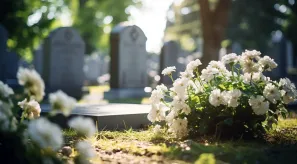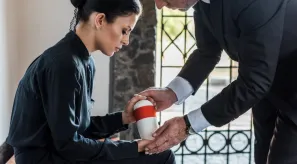In our country, funerals usually involve solemnity and quiet reflection, with grief and sadness taking centre stage. However, certain cultures approach death from a completely different angle, viewing it as an opportunity to celebrate life.
Exploring examples of what culture celebrates death, how they do it, and how this influences grieving can broaden your perspective, offering a constructive approach to a painful situation. This can transform grief into a heartfelt tribute full of love and gratitude towards those who have passed on.
Which cultures celebrate death and why?
You’ve probably seen it in films and documentaries: certain cultures celebrate the death of family and friends very differently from the farewell rituals we're used to. Understanding their motivation and where they find the strength to do this can offer us valuable insights.
How death is perceived in different traditions
In some traditions, death is not viewed as an absolute end, but rather as another step in the cycle of existence.
- For instance, Buddhists believe death represents a transition into another reincarnation, and their funeral rituals are specifically designed to facilitate this passage.
- For many Andean peoples, death is viewed as a return to Pachamama—Mother Earth—symbolising life’s continuation in another form.
These viewpoints provide a broader and less fearful understanding of death.
Cultures honouring life through death
Some cultures, instead of focusing purely on mourning, choose to celebrate the life of the deceased. A great example can be found in Indonesia among the Toraja people, who turn funerals into multi-day ceremonies honouring the departed with dances and animal sacrifices.
Such practices enable communities to positively and collectively commemorate and celebrate the life of their loved ones.
How beliefs shape funeral rituals
Funeral rites are deeply influenced by the religious and cultural beliefs of each society.
- In Hinduism, cremation is seen as freeing the soul from the body, facilitating its reincarnation.
- In Christianity, funerals embody the hope of eternal life and resurrection.
These beliefs significantly shape emotional attitudes toward death. That is the reason why being open to different perspectives can help us find more personal ways to say farewell to our loved ones.
Examples of cultures that celebrate death
Numerous cultures worldwide turn the act of saying goodbye top a loved one into a celebration of life. Here are some notable examples:
Mexico's Day of the Dead: a living tradition
This festival, celebrated on 1 and 2 November in Mexico, differs greatly from our customs for All Saints' Day, despite coinciding in dates.
It’s a celebration honouring the deceased through altars decorated with marigolds, candles, their favourite foods, their personal items, and photographs. Families also visit cemeteries, bring offerings, and share stories, creating a festive atmosphere that commemorates and positively celebrates the lives of those no longer physically present but who remain vividly in memory and heart.
Funeral rites in Ghana: colourful coffins and celebrations
In this African country, particularly among the Ga people, funerals are significant social events featuring brightly coloured custom-made coffins known as ‘abebuu adekai’. These coffins are crafted into shapes representing the deceased’s profession or passions, such as fish, aeroplanes, or tools, symbolising their life and legacy. The ceremonies include music, dancing, and feasting.
Tibetan sky burials: returning to nature
In Tibet, the sky burial or ‘jhator’ involves offering the deceased’s body to vultures on sacred mountains. This Buddhist tradition symbolises generosity and detachment, viewing the body as an empty vessel once the soul has departed, and highlighting a profound connection to nature and belief in reincarnation.
Japan’s Obon festival: honouring ancestors
This final example is another Buddhist festival, this time from Japan, celebrated in August to honour ancestral spirits. Families clean graves, offer food, and light lanterns to guide the spirits back home. Celebrations include traditional dances known as ‘Bon Odori’ and floating lantern ceremonies, creating an atmosphere of respect and joy honouring the deceased.
How celebrating death impacts grieving
Transforming farewells into a celebration of life can offer comfort, strengthen family and friendship bonds, and support healthier acceptance of loss.
Emotional benefits of turning grief into celebration
Celebrating a loved one’s life allows people to remember happy moments and share anecdotes, alleviating pain and fostering positive memories.
How cultural rituals aid acceptance of loss
Cultural rituals provide structured frameworks that guide people through grief, creating a space to express emotions and pay tribute to the deceased.
Frequently asked questions about cultures that celebrate death
How can I include cultural elements in a funeral?
Personalising the ceremony with cultural elements will allow you to honour the deceased’s traditions. You can incorporate music, serve traditional dishes, use cultural symbols, or perform rituals of your choice.
Is it possible to combine traditions from different cultures?
Yes, absolutely. At Stelae, we specialise in customising such ceremonies. Please feel free to consult us regarding any details, and we will guide you throughout the entire process.



